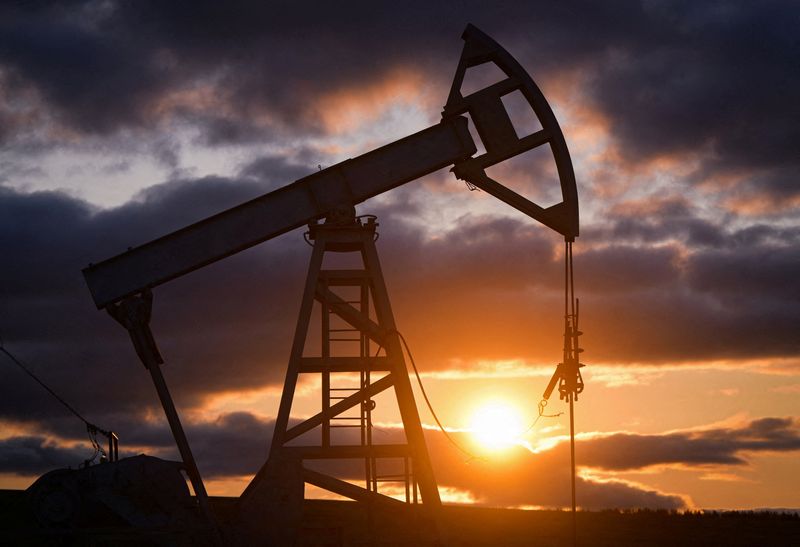Commodities
Explainer-OPEC+ oil policies: what cuts are already in place and what could change


© Reuters. FILE PHOTO: A view shows an oil pump jack outside Almetyevsk in the Republic of Tatarstan, Russia June 4, 2023. REUTERS/Alexander Manzyuk/File Photo
By Alex Lawler
LONDON (Reuters) – Saudi Arabia, Russia and other members of OPEC are scheduled to meet in Vienna on Sunday and could make further changes to an agreement that already limits supply into 2024, according to analysts and OPEC+ sources, to support the market.
Saudi Arabia, Russia and other members of the OPEC+ group of oil-producing countries have already pledged oil output cuts of about 5 million barrels per day (bpd), or about 5% of daily global demand, in a series of steps that started in late 2022.
This figure includes a 1 million bpd voluntary reduction by Saudi Arabia and a 300,000 bpd cut in Russian oil exports, both of which last until the end of 2023.
WHAT IS AGREED ALREADY FOR 2024?
OPEC+ at its last meeting in June extended oil output cuts of 3.66 million bpd, amounting to 3.6% of global demand, until the end of 2024.
That figure comprises a 2 million bpd cut agreed in 2022, and a further 1.66 million bpd in voluntary cuts from nine OPEC+ countries agreed earlier this year.
The group also cut its overall production targets from January 2024 by a further 1.27 million bpd versus current targets to a combined 40.58 million bpd, including a later adjustment made to Russia’s 2024 target.
Including the additional voluntary cuts, which the nine participating countries extended to the end of 2024, this results in an even lower implied target in 2024 according to Reuters calculations (see table).
In real terms though, this is around 740,000 bpd higher than OPEC+’s October 2023 production compared with International Energy Agency (IEA) figures, given the impact of the 1 million bpd Saudi voluntary cut being in place.
Targets for several African members were reduced to bring them in line with declining production levels. The agreement also allows the United Arab Emirates, which has been boosting its production capacity, to increase output in 2024.
WHAT MORE COULD THEY AGREE ON SUNDAY?
Three OPEC+ sources told Reuters last week OPEC+ is set to consider whether to make additional oil supply cuts when the group meets.
OPEC+ could further revise 2024 targets for Nigeria, Angola and Congo after reviews by outside analysts, it said in June. Angola and Congo are pumping below their 2024 targets due to falling capacity, while Nigeria has moved closer to or surpassed its 2024 target in recent months according to some assessments.
Some analysts, including Energy Aspects, expect Saudi Arabia to extend its 1 million bpd voluntary cut to at least the first quarter of 2024.
The following table shows OPEC+ production and targets in 2023-2024 in million barrels per day:
Country October May-Dec. May-Dec. 2023 2024 Implied 2024 target
2023 2023 targets with targets with voluntary cuts^
output* targets voluntary cuts**
Algeria 0.96 1.007 0.959 1.007 0.959
Angola 1.15 1.455 1.455 1.28 1.28
Congo 0.26 0.31 0.31 0.276 0.276
Equatorial 0.06 0.121 0.121 0.07 0.07
Guinea
Gabon 0.22 0.177 0.169 0.177 0.169
Iraq 4.38 4.431 4.22 4.431 4.22
Kuwait 2.57 2.676 2.548 2.676 2.548
Nigeria 1.35 1.742 1.742 1.38 1.38
Saudi 9.01 10.478 9.978 10.478 9.978
Arabia
UAE 3.25 3.019 2.875 3.219 3.075
Azerbaijan 0.49 0.684 0.684 0.551 0.551
Kazakhstan 1.63 1.628 1.55 1.628 1.55
Mexico 1.67 1.753 1.753 1.753 1.753
Oman 0.8 0.841 0.801 0.841 0.801
Russia*** 9.53 10.478 9.5 9.949 9.449
Bahrain*** 0.85 0.196 0.196 0.196 0.196
*
Brunei 0.097 0.097 0.083 0.083
Malaysia 0.567 0.567 0.401 0.401
South 0.124 0.124 0.124 0.124
Sudan
Sudan 0.072 0.072 0.064 0.064
Total 23.21 25.416 24.377 24.994 23.955
OPEC-10
Total 14.98 16.44 15.344 15.59 14.972
Non-OPEC
Total 38.19 41.856 39.721 40.584 38.927
OPEC+
* IEA figures
** Excludes Saudi Arabia’s additional 1 million bpd voluntary cut from July 2023 to December 2023.
. *** Russia’s 500,000 bpd voluntary cut is from March 2023 to December 2024 to around 9.5 million bpd, according to Deputy Prime Minister Alexander Novak. Russia’s 2024 target is based on a revision announced by OPEC on June 13.
**** Figure is total for Bahrain, Brunei, Malaysia, Sudan and South Sudan
^ Includes extra voluntary cuts when announced
Commodities
Oil prices rise; U.S. crude inventories plunge, Russia-Ukraine truce eyed
Commodities
India’s Reliance to stop buying Venezuelan oil over US tariffs, sources say
Commodities
Oil prices climb on Venezuela supply worries

 Forex3 years ago
Forex3 years agoForex Today: the dollar is gaining strength amid gloomy sentiment at the start of the Fed’s week

 Forex3 years ago
Forex3 years agoUnbiased review of Pocket Option broker

 Forex3 years ago
Forex3 years agoDollar to pound sterling exchange rate today: Pound plummeted to its lowest since 1985

 Forex3 years ago
Forex3 years agoHow is the Australian dollar doing today?

 Cryptocurrency3 years ago
Cryptocurrency3 years agoWhat happened in the crypto market – current events today

 World3 years ago
World3 years agoWhy are modern video games an art form?

 Commodities3 years ago
Commodities3 years agoCopper continues to fall in price on expectations of lower demand in China

 Economy3 years ago
Economy3 years agoCrude oil tankers double in price due to EU anti-Russian sanctions























